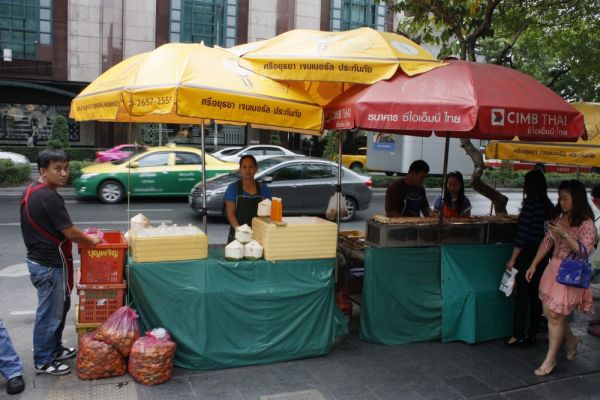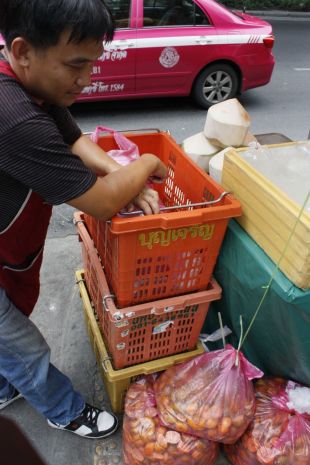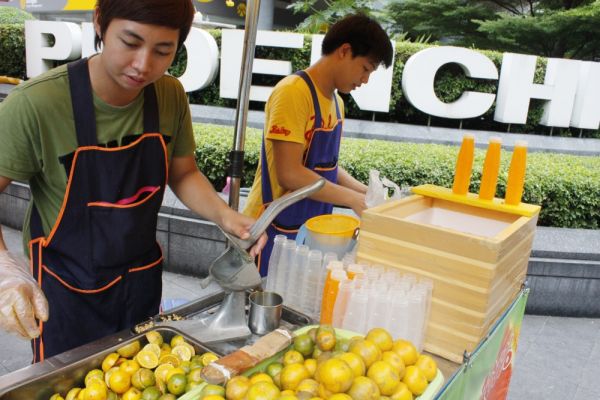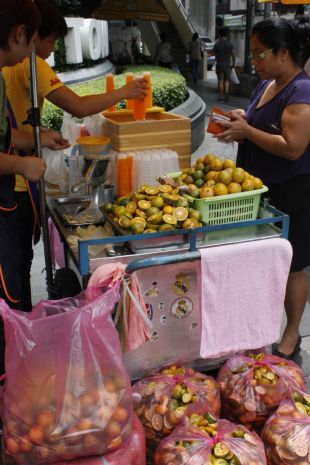Vendors Squeeze a Profit Out of Office Workers Seeking Chemical-Free Juice

Nut is shaded by two yellow umbrellas with the name of a Thai insurance group advertised on them. Canvas umbrellas in blaring colors are a staple of Bangkok’s streetscape.
I’m in the midst of a health kick, both physical and mental, an effort in which fresh juice has become a key part. Not juice from cartons, which is usually flavored with chemicals to make each serving taste exactly the same. I’m talking about the fresh-squeezed stuff – textured and thick, with a complexity only nature can create – that you can get from the street vendors who line Bangkok’s sidewalks for 20 baht per bottle.
The juice sold on the street is a great value, but the taste varies from vendor to vendor – some is tangy, some sweet, some pulpy – so I wanted to make sure that it’s really as fresh as the sellers claim. Given that cheap concentrated solutions and manufactured pulp are widely available, I wondered if some vendors cook up with their own artificial concoctions and pass them off as fresh. With today’s advanced chemical trickery, I don’t even trust my own tongue.
It’s not hard to find juice stalls in Bangkok nowadays, but many of them have their juice in a bottle, ready to pour. I wanted to find ones that actually cut, press and bottle their juices right before my eyes. Only then could I trust that the product is 100 percent real (like this guy’s is).
Luckily, a few weeks ago I found two juice stalls near where I live, an affordable luxury. (By “near,” I mean a 60 baht ride by motorcycle taxi – about $2 USD).

Kai working with the 25-kilogram baskets used for carrying oranges. One of Bangkok’s iconic pink taxis can be seen behind him.
The first stall is opposite Central Chidlom, a department store owned by Central Group, a large retail-and-restaurant conglomerate in Bangkok. It is one of many stalls that line the curbside, and this being lunchtime, everybody around me seems to be rushing somewhere. White-collars are strutting and chatting with their colleagues, dodging people, sidestepping bad terrain and impulse-buying snacks on sticks. Funnily enough, the encroachment on the sidewalk by these vendors is tacitly endorsed by large, formal institutions – banks, insurance companies and multinationals like Visa and Coca-Cola advertise on the large canvas umbrellas that provide shelter for these vendors. (Perhaps they realized that the fight against informal vendors in Thailand is unwinnable – if you can’t beat ‘em, join ‘em).
Here I find Kai and Nut, husband and wife, who have been selling orange and coconut juice for more than 13 years. “Ten years ago was a lot better,” says Kai. Oranges were cheaper back then, profit margin was higher. “Before, there were not many competitors,” he adds.
“We have been selling since it was four to five baht a kilo. Now it’s 40,” says Kai. A kilo of Rangsit-variety oranges can make three small bottles of juice, giving them 60 baht in sales. The stall can thus seemingly turn a profit of 20 baht per kilo. But this doesn’t take into account other overhead costs like transportation, packaging, cleaning, etc. Kai and Nut source from middlemen who get the oranges straight from the plantation. They don’t buy the expensive citrus fruit or the ones “with stickers” from supermarkets. They turn 200 kilos of oranges into juice every two to three days.
Coconuts generate a decent profit too, though not as much as orange juice. They go through around 50 or 60 coconuts each day, also pocketing about 20 baht per kilo. Nut scoops the flesh from a young coconut with a small wedge spoon – the same spoon that the Thais use for eating noodles – and pours the coconut water and its white flesh into a transparent bag. Once she’s tied it shut with a rubber band, the bag is puffed up like a balloon. About a dozen of the bags are on display, resting on a bed of ice inside a foam box.

Cousins Menn and Arm churning out fresh fruit juice for the masses.
“Why don’t you try the coconut juice, too?” suggests a customer standing next to me, whose name I soon learn is Somporn. It’s a pleasant surprise to find another soul who dares chat with a stranger without a hidden agenda. I don’t know exactly how much of Nut and Kai’s business comes from word-of-mouth, but Somporn’s recommendation suggests it’s a factor. I ask her if she’s an office worker around Chidlom. “I’m too old for that, darling,” she purrs. “I only play the stock market.”
“Coconut juice is great for postmenopausal women like me,” she confides (apparently we’re that familiar already), “because it contains growth hormones… It’s not a lot, but it’s suitable for an aged person. It can also replenish the minerals after exercise.”
At home, Somporn squeezes and drinks Shogun-variety orange juice – the coconuts cost her 80 baht per kilo. In addition of the goodness of the juice itself, making it at home has its benefits. “I make sure that my daughter squeezes orange juice for her dad every day,” Somporn says with satisfaction. This is to “train” her daughter in filial piety, she says. The idea of her feeding her husband fresh juice seems to be less important.
Somporn then turns her attention to Nut. She hands over a 20-baht note for a bag of ready-to-drink coconut juice with a straw sticking out. “How do you clean the oranges?” Somporn asks.
“We wash them, then dry them in the sun for two days, and then wash them again in water twice,” says Nut, her eyes brightening and her lips turning up into a shy smile. It seems that she’s never have a chance to tell anyone about this extra step of care. Somporn agrees with Nut that this is the best way to clean the fruit (she does the same at home) because if the oranges aren’t cleaned properly, the rind of the fruit will make the juice bitter.
Somporn departs the scene. At one o’clock, her workday is already over.
Thirty seconds down the road is the other stall, opposite another shopping center owned by Central Group, an under-construction mall to be called Central Embassy.

The many bags of discarded orange rinds are testament both to their work ethic and the fact that their juice is 100 percent fresh and authentic.
A pair of 20 year olds, Menn and Arm, are frantically slicing small oranges in half and pressing them with metal kitchenware into a canteen cup. Menn switches between the knife and the orange press with diligent speed. Arm, his cousin, fills the bottles with juice and does the selling. Next to them are hundreds of squashed orange halves, stuffed in transparent bags, to show that the juice they make is real. Real juices made and sold by real men, is the implication – men who care about the well-being of others.
I get the feeling that the first and second stall don’t really compete. They seem to rely more on their loyal, long-time customers, office workers who habitually come out for their daily vitamin intake.
Their efforts pay off. Astoundingly, Menn and Arm can sell one ton of juice per week, or 500 to 600 bottles daily. They’ve been doing this for three years. Menn’s brother set up another stall nearby.
Without a doubt, this is the best juice available on the street, and I come to the conclusion that the taste depends on the variety of orange, the season, the blend and the size of the fruit. All of these factors differ from stall to stall.
I ask Menn how long they will continue to sell orange juice. “Until they chase us out,” he repiles, a familiar story to most informal vendors in Bangkok, and indeed elsewhere around the world.
Photos by Witchaya Pruecksamars









